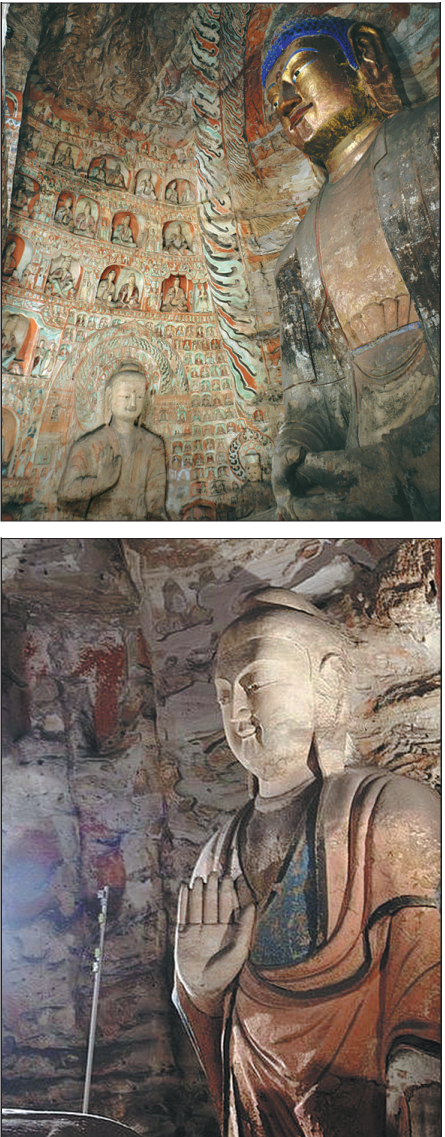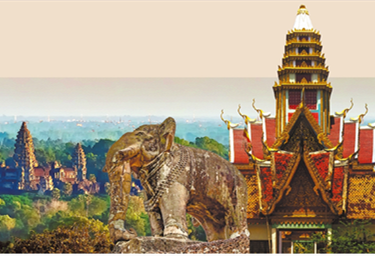Protecting Yungang a generational task

Two statues in Grotto 5 of the Yungang Grottoes in Datong, Shanxi province. [Photo/China Daily]
The 1,500-year-old site is one of three most famous Buddhist grottoes in country
Staff at the Yungang Grottoes Academy have been busy conducting regular maintenance at the site in Datong, Shanxi province.
According to a statement, grottoes 7 and 8 were closed on March 29 for safety upgrades. The project was finished recently.
On March 15, Grotto 5 reopened to the public after 10 days' work.
Grotto 5, which contains some 2,300 Buddhist statues, is 17.4 meters high and 18.7 meters wide and is known for its 17.4-meter-tall Buddha statues, the tallest in the grottoes.
Located in the northern Shanxi city of Datong, the Yungang Grottoes are one of the three most famous Buddhist grottoes in China. The other two are Mogao in Dunhuang, Gansu province, and Longmen in Luoyang, Henan province.
The Yungang Grottoes were created 1,500 years ago during the Northern Wei Dynasty (386-534) period, when Datong, then called Pingcheng, was the national capital.
They were carved out of the sandstone cliffs of Wuzhou Mountain, today in the northwestern suburbs of Datong.
According to historical records, 254 main caves were carved during the period from 460 to 524.
Today, 45 remain intact, housing more than 59,000 statues with heights ranging from just a few centimeters to more than 17 meters.
Yungang was included on the UNESCO World Cultural Heritage list in 2001.
"After being battered by wind, rain and snow over 1,500 years, protecting this precious cultural heritage site has become a pressing challenge," said Yan Hongbin, director of the academy's conservation and restoration laboratory of cultural relics.
"With the development of modern industry in the 20th century, the Yungang Grottoes have faced serious environmental pollution and accelerated deterioration.
"Since the foundation of the specialized administration for Yungang in 1955, a great deal of conservation and management work has been done over the generations to protect the site," he said.
The first large-scale restoration project was carried out between 1974 and 1976 and mainly focused on reinforcement work, as some of the caves and carvings were on the verge of collapse.
Since 2015, professionals in stone cultural relic protection have been carrying out annual surveys and formulated a Yungang Grottoes degeneration investigation graphic standard, which includes classification, mapping, description, analysis and reporting on the levels of degeneration in the caves.
Surveys were conducted in 20 grottoes to accumulate the firsthand information needed to set a reliable basis for decision-making when it comes to the management of the grottoes, he said.
"The protection of the Yungang Grottoes has changed from rescue work to prevention and protection, and will change to research and protection in the future," Yan said.
"Current protection can be divided into internal protection, external protection and environmental protection, as well as related preventive protection and monitoring, safety protection and technology protection."
Since 2015, the academy has conducted internal protection in 20 grottoes and greatly improved the preservation of temples and painted murals.
"We have basically completed external protection of the Yungang Grottoes," he said.
"This refers to the mountain in which the caves are dug."
Now, the academy has a protection team of around 20 members, some of them local villagers.
"They have lived here since childhood, so they have a deep affection for Yungang," Yan said. "After several years of training and practice, they also have a deep understanding of the concept, technology, materials and other aspects of cultural relic protection and restoration.
"However, the conservation of the site is a large, systematic project with quite a heavy workload," he said.
"We hope more people will join the team so research capabilities can be gradually enhanced."
Peng Ke'er contributed to this story.
Contact the writers at zhouhuiying@chinadaily.com.cn


